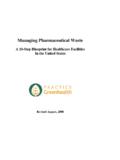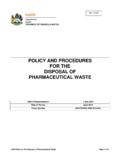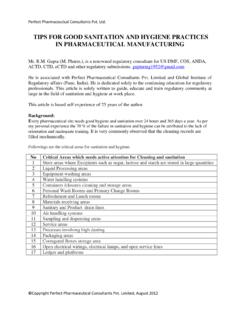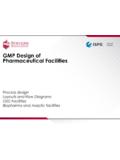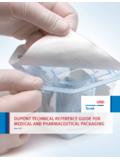Transcription of Fundamentals of health-care waste management - …
1 United Nations Environment Programme / SBC world health organization National health - care waste management Plan Guidance Manual 7 Fundamentals of health - care waste management (1) This section provides general information on HCW and key elements of management procedures that are essential to know before developing a HCWM plan. It includes the following: The need for the development of supervision and management structures; A presentation of the risks associated with HCW; A definition and a classification of HCW; The minimum observance that should be respected for HCWM; A guidance for the specific management of hazardous and infectious HCW; Indications for the development of protective measures for HCF staff and the environment.
2 Supervision and management structures for HCW (2) HCWM is first of all a management issue before being a technical one and therefore completely depend on the commitment of the entire staff within HCFs. This dedication will only be possible if people are first of all properly trained and made aware of the risks that this particular type of waste poses. It is therefore important to make sure the curricula of medical and para-medical staff includes this important public- health issue (see for further information). (3) When a new staff member is engaged, it is highly recommended that a specific clause regarding the safe management of HCW be included in the contract, so as to make the new employee fully aware of the importance of this part of his/her work and made liable in this respect.
3 (4) To make sure HCW is properly managed on the long term, it is important to supervise on a regular basis the practices of the staff. This should be performed by the HCWM officer and/or members of a HCWM committee within each HCF (depending on the size of the facility). Typically members of such a committee are usually the same as those in charge of nosocomial infections. Appropriate on-going training and awareness sessions should be organised accordingly to keep practices at the best standards possible. (5) To support the HCWM officer and/or these HCWM committees, regional and national support should be provided (see for further details about the support structure). These regional and national management teams are there to supply the HCF level with the necessary technical backstopping to both ensure standard and harmonized procedures are applied and facilitate the daily work of the HCWM officer and members of the HCWM committees.
4 Risks associated with HCW (6) All individuals exposed to hazardous HCW are potentially at risk of being injured or infected. They include: Medical staff: doctors, nurses, sanitary staff and hospital maintenance personnel; In- and out-patients receiving treatment in health - care facilities as well as their visitors; Workers in support services linked to health - care facilities such as laundries, waste handling and transportation services; Workers in waste disposal facilities, including scavengers; The general public and more specifically the children playing with the items they can find in the waste outside the health - care facilities when it is directly accessible to them. (7) Supporting the Governments in the implementation of adequate procedures to minimise the overall risks associated with HCW management remains the prior objective of this Guidance Manual.
5 waste management and treatment options should first protect the health - care workers and the population and minimise indirect impacts from environmental exposures to HCW. United Nations Environment Programme / SBC world health organization National health - care waste management Plan Guidance Manual Occupational and public health risks (8) During handling of wastes, the medical and ancillary staff as well as the sanitary labourers can be injured if the waste has not been packed safely. In that respect, sharps are considered as one of the most dangerous category of waste . Many injuries occur because syringe needles or other sharps have not been collected in safety boxes or because these have been overfilled. On dumpsites, scavengers during their recycling activities may also come in contact with infectious waste if it has not been properly treated or disposed of.
6 (9) The general public can be infected by HCW either directly or indirectly through several routes of contamination. Dumping HCW in open areas is a practice that can have major adverse effects on the population. The recycling practices that have been reported, particularly, the reuse of syringes is certainly the most serious problem in some of the developing countries. The WHO estimates that over 20 million infections of hepatitis B, C and HIV occur yearly due to unsafe injection practices (reuse of syringes and needles in the absence of sterilization)1. There is a risk for public health as regards the sale of recovered drugs in the informal sector and the lack of controls.
7 Illustration 1: When people are scavenging, the risk of needle stick injuries increases greatly Indirect risks via the environment Finally, the dumping of HCW in uncontrolled areas can have a direct environmental effect by contaminating soils and underground waters. During incineration, if no proper filtering is done, air can also be polluted causing illnesses to the nearby populations. This has to be taken into consideration when choosing a treatment or a disposal method by carrying out a rapid environmental impact assessment. Illustration 2: the soil and underground water can be contaminated with heavy metals and other toxic products that may enter the food Definitions and classification of health - care waste (10) health - care waste includes all the wastes generated by medical activities.
8 It embraces activities of diagnosis as well as preventive, curative and palliative treatments in the field of human and veterinary medicine. In other words, are considered as health - care waste all the wastes produced by a medical institution (public or private), a medical research facility or a laboratory. 1 WHO Fact sheet n 231, April 2002 ( ) United Nations Environment Programme / SBC world health organization National health - care waste management Plan Guidance Manual 9(11) As mentioned earlier, an effort to bring together medical staff with waste managers has been made by combining the environmentally and pragmatic oriented approach of the second with the public health safety concerns and principles of precaution of the first.
9 (12) According to the Technical Guidelines on Environmentally Sound management of Biomedical and health - care waste provided by the Conference of the Parties to the Basel Convention on the Control of Trans-boundary Movements of Hazardous waste and their Disposal (December 2002), health - care waste are classified as follows2 (see figure 1): Figure 1: Classification of HCW 2 The classification has been re-transcribed as such with two modifications only for the health - care waste of categories A and C. They have been divided into three and two classes respectively for practical but also public- health safety reasons to respect the most important aspects of the precautionary principals recommended by the WHO.
10 United Nations Environment Programme / SBC world health organization National health - care waste management Plan Guidance Manual 10A Non-risk HCW (13) Non-risk HCW includes all the waste that has not been infected like general office waste , packaging or left over food. They are similar to normal household or municipal waste and can be managed by the municipal waste services. They represent between 75% and 90% of the total amount of HCW generated by medical institutions. Three groups can be established: A1 Recyclable waste (14) It includes paper, cardboard, non-contaminated plastic or metal, cans or glass that can be recycled if any recycling industry exists in the country.










